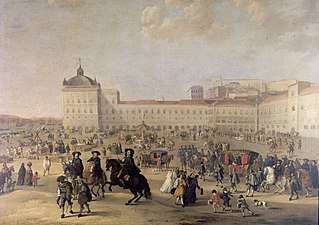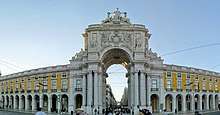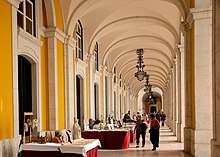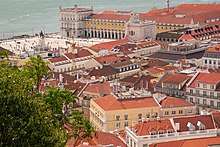Praça do Comércio
The Praça do Comércio (Portuguese pronunciation: [ˈpɾasɐ du kuˈmɛɾsju]; English: Commerce Square) is located in the city of Lisbon, Portugal. Situated near the Tagus river, the square is still commonly known as Terreiro do Paço ([tɨˈʁɐjɾu du ˈpasu]; English: Palace Yard),[1] because it was the location of the Paços da Ribeira (Royal Ribeira Palace) until it was destroyed by the great 1755 Lisbon earthquake. After the earthquake, the square was completely remodeled as part of the rebuilding of the Pombaline Downtown, ordered by Sebastião José de Carvalho e Melo, 1st Marquis of Pombal, who was the Minister of the Kingdom of Portugal from 1750 to 1777, during the reign of Dom José I, King of Portugal.[2]
Praça do Comércio Terreiro do Paço | |
|---|---|
Square | |
.jpg) | |
| Nickname(s): Terreiro do Paço | |
| Country | Portugal |
| Province | Estremadura |
| City | Lisbon |
| Approx. Size | 35.000 m2 |
| Parishes | Santa Maria Maior |
History


Urban development of the banks of the Tagus river (the Ribeira) was given a definitive impulse in the early 16th century, when King Manuel I built a new royal residence – the Ribeira Palace – by the river, outside the city walls. The area was further developed with the building of a port, shipbuilding facilities (the Ribeira das Naus), the Casa da Índia and other administrative buildings that regulated the commerce between Portugal and other parts of Europe and its colonies in Africa, Asia and the Americas.
On 1 November 1755, during the reign of King Dom José I, a great earthquake followed by a tsunami and fire destroyed most of Lisbon, including the Ribeira Palace and other buildings by the river. José I's Prime Minister, the Marquis of Pombal, coordinated a massive rebuilding effort led by Portuguese architect Eugénio dos Santos. He designed a large, rectangular square in the shape of a "U", open towards the Tagus.[2] The buildings have galleries on their ground floors, and the arms of the "U" end in two large towers, reminiscent of the monumental tower of the destroyed Ribeira Palace, still vivid in the architectural memory of the city. His plan was realised almost completely, although decorative details were changed and the east tower of the square and the Augusta Street Arch were only finished in the 19th century.[3] This triumphal arch was designed by the Portuguese architect Santos de Carvalho and was completed in 1873. The top section includes statues representing important Portuguese figures such as Vasco da Gama and the Marquis of Pombal.[4]
The square was named Praça do Comércio, the Square of Commerce, to indicate its new function in the economy of Lisbon. The symmetrical buildings of the square were filled with government bureaux regulating customs and port activities. The centrepiece of the ensemble was the equestrian statue of King José I, inaugurated in 1775 in the centre of the square. This bronze statue, the first monumental statue dedicated to a king in Lisbon, was designed by Joaquim Machado de Castro, Portugal's foremost sculptor of the time.[3]


Opening towards Augusta Street, which links the square with the other traditional Lisbon square, the Rossio, the original project by Eugénio dos Santos planned a triumphal arch,[2] only realised in 1875. This arch, usually called the Arco da Rua Augusta, was designed by Veríssimo da Costa.[3] It has a clock and statues of Glory, Ingenuity and Valor (by the French sculptor Calmels) and those of Viriatus, Nuno Álvares Pereira, Vasco da Gama and, of course, the Marquis of Pombal.[3]
On 1 February 1908, the square was the scene of the assassination of Carlos I, the penultimate King of Portugal. On their way back from the palace of Vila Viçosa to the royal palace in Lisbon, the carriage containing Carlos I and his family passed through the Terreiro do Paço. While crossing the square, shots were fired from the crowd by at least two men: Alfredo Luís da Costa and Manuel Buiça. The king died immediately, his heir Luís Filipe was mortally wounded, and Prince Manuel was hit in the arm. The assassins were shot on the spot by police[5] and later recognized as members of the Republican Party – which two years later overthrew the Portuguese monarchy.
The wealth of Portugal was channeled through this plaza and port. It serves as not only a transportation hub but also as a hub for commercial businesses, having two main directions of travel, west and south. The northern side tram leads to the district of Belem and the southern port is a ferry that goes across the River Tagus.
The destruction of the palace led to the loss of the greatest archive of Portuguese literature. The library housed over 200,000 thousand books. The reconstruction took around a century to go from plans to finished construction.

At the southern end of the plaza at the water's edge was a grand marble staircase meant for the arrival of royal dignitaries.[6] These steps date to before the 1755 earthquake and would have led straight into the royal palace.
On June 10, the day of Portugal, the plaza is full of military and residents who celebrate the day.[7]
The plaza is home to the oldest café in the city, Martinho da Arcada (established 1782). It also houses the monumental Pousada Hotel.[8]
Commerce Square has been classified as a National Monument of Portugal since 1910.[2][3]
.jpg)
The western tower of the squares houses the Baixa's location of the Museum of Lisbon.
See also
- Pombaline Downtown
- Ribeira Palace
- Casa da Índia
- Rossio
- Praça da Figueira
References
- Itinerario Lisbonense (in Portuguese). 1818 [1804].
- "Praça do Comércio". patrimoniocultural.gov.pt (in Portuguese). Archived from the original on 2018-04-20. Retrieved 2018-04-20.
- "Commerce Square". www.monumentos.gov.pt (in Portuguese). Archived from the original on 2018-04-20. Retrieved 2018-04-20.
- https://www.lisbon.net/commerce-square, Commerce Square
- Newitt, Malyn. The Braganzas. pp. 283–284. ISBN 978-1-78914-125-2.
- https://lisbonlisboaportugal.com/Baixa-Lisbon/praca-do-comercio-lisbon-portugal-guide.html
- Correio da Manhã, Commerce Square Full For June 10, Lisbon June 10th 2016, 1.
- https://www.lisbonlux.com/lisbon/praca-do-comercio.html
- França, José-Augusto (1980). Lisboa: Arquitectura e Urbanismo. Biblioteca Breve (in Portuguese). Instituto de Cultura e Língua Portuguesa (ICALP).
External links
| Wikimedia Commons has media related to Praça do Comércio. |
- General Bureau for National Buildings and Monuments (Portugal)
- Presentation showing a virtual reconstruction of the Terreiro do Paço just before the 1755 earthquake
- Interactive Panorama: Praça do Comércio
